Molto Grazie, Magnificent Milan
Much is made of Milan’s modern outlook and renown as a fashion center, but I was struck by the beauty of it’s historic architecture, and magnificent, broad tree-lined avenues.
We had left Cinque Terre‘s Monterosso al Mare village early in the morning, catching a train that would take us to Milan in Italy’s Lombardy region. Thankfully we had reserved our first-class train seats in advance, as it was full.
Milano Centrale Railway Station
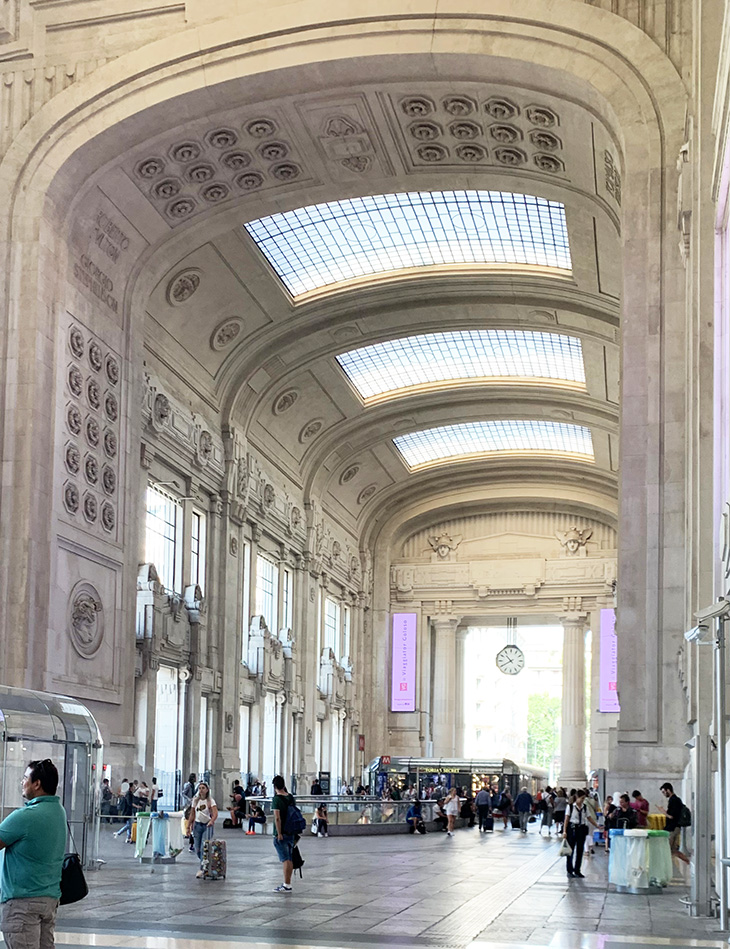 (Milano Centrale Railway Station Interior Gallery, Italy Photo: Anita Hamilton / 50+ World)
(Milano Centrale Railway Station Interior Gallery, Italy Photo: Anita Hamilton / 50+ World)
Milano Centrale railway station was the first building we saw in Milan after getting off the train – and it was an impressive sight to see, with it’s high ceilings, beautiful walls, and marble floors. Italy’s King Victor Emanuele III laid the cornerstone of this station in 1906, but construction on it didn’t even begin until after architect Ulisse Stacchini’s design was declared a winner in 1912.
When Il Duce (National Fascist Party leader Benito Mussolini) became Prime Minister of the Kingdom of Italy in 1922, he pushed for completion of new and ongoing public works projects. His changes to the design of the Milano Centrale railway station made it a more imposing building when it opened in 1931.
Historical Note #1: Benito Mussolini had been a prominent socialist, Marxist, and journalist in Trento, Italy, until the advent of World War I. The Italian Socialist Party that he belonged to opposed Italian involvement in WWI, and kicked him out when he promoted involvement in the war to support revolutionary social changes in Italy. In 1914 Mussolini denounced socialism and formed a new political movement whose members called themselves Fascists.
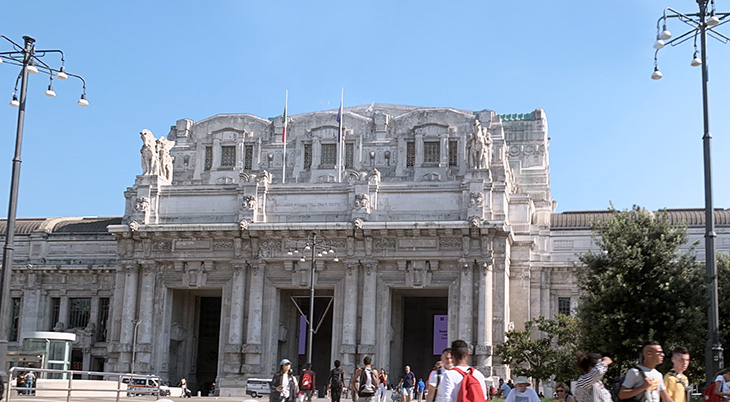 (Milano Centrale Train Station Gray Stone Portico, Italy Photo: Anita Hamilton / 50+ World)
(Milano Centrale Train Station Gray Stone Portico, Italy Photo: Anita Hamilton / 50+ World)
Mussolini is widely credited with making the trains run on time in Italy, although this may have been more a nod to propaganda and some efficiency improvements already in the works before he came to power, than actually being on time to the minute as claimed. Our own train was on time for departure from Monterosso, but as the three-hour train trip to Milan slid into the fourth hour, a fellow traveler commented in frustration, “They’re always late.”
Historical Note #2: In September 1943, Italy surrendered to Germany during WWII. Approximately 1,200 Jewish prisoners captured by German troops occupying northern Italy (Genoa, Turin, Milan, and other cities) were taken to a secret track underneath the Milano Centrale train station. A WWII Holocaust memorial at the Milan train station commemorates these events and honors the memory of the Jewish prisoners sent from this station, to either Nazi extermination camps such as Auschwitz, Bergen-Belson, Mathausen, or concentration camps at Bolzano or Fossoli.
The Milan train station was a filming location for some scenes in the 1972 adventure comedy Travels With My Aunt (1972), starring Maggie Smith, Louis Gossett Jr., Alec McCowen and Cindy Williams.
Modern Milan
We hailed a taxi from the train station to take us to the Milan Crowne Plaza Hotel, which turned out to be less than a five minute cab ride. The hotel was sparkling clean and modern, in the business area of Milan.
A stroll around adjacent blocks in the blazing mid-day heat took us past a few interesting looking buildings, including a “Canadian School” which struck us as coincidental.
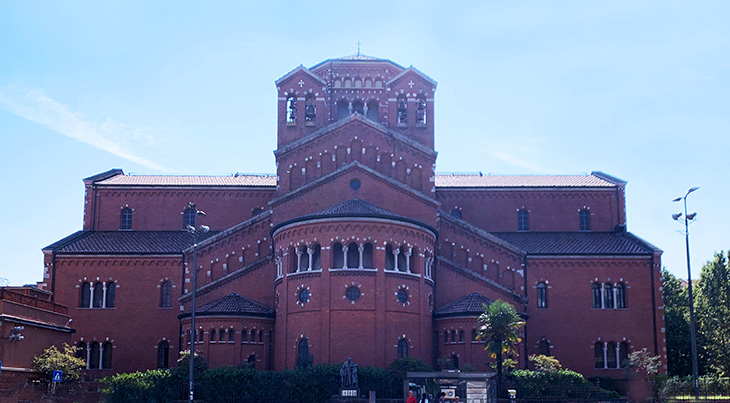 (Salesian Institute Sant’Ambrogio, Milan, Italy Photo: Anita Hamilton / 50+ World)
(Salesian Institute Sant’Ambrogio, Milan, Italy Photo: Anita Hamilton / 50+ World)
The impressive building above is on Via Copernica near our hotel in Milan. It’s a private school, the Salesian Institute Sant’Ambrogio.
We ducked down a quiet, shaded side street lined with large residences and mature trees, to escape the sun’s glare. Uniformed armed guards outside one building alerted us to the presence of a foreign government, which turned out to be the Cuban Consulate. There are several other embassy’s in this area as well.
An tall brick wall with a gated entrance and the sign Da Berti announced a restaurant. Peeking through the bars of the iron gate we could see a private courtyard with a small garden on one side and a shaded outside seating area on the other. Time for lunch!
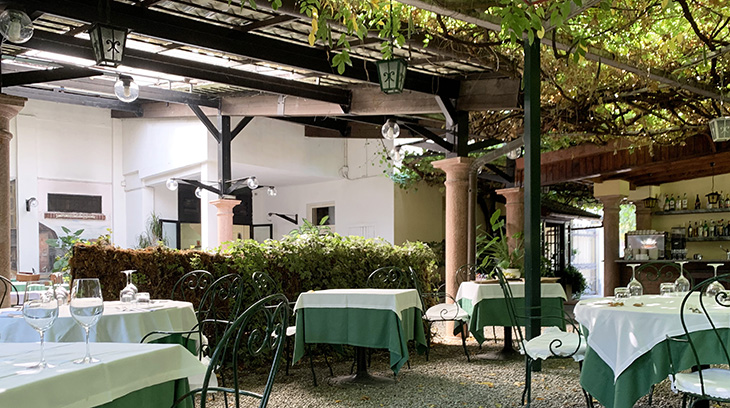 (Da Berti Restaurant, Via Francesco Agarotti, Milan, Italy Photo: Anita Hamilton / 50+ World)
(Da Berti Restaurant, Via Francesco Agarotti, Milan, Italy Photo: Anita Hamilton / 50+ World)
Our charming water Danilo spoke almost perfect English (he’d spent 15 years in the U.S.), providing wonderful service in a unique and relaxing setting. Vines and trees completely shaded the restaurant’s cobblestone outdoor seating area.
I later learned from their website that the Da Berti restaurant was established in 1866, the same year that construction began on the Galleria Vittorio Emanuele II. It was too early in the day for us to want wine, but apparently the Da Berti wine cellars under the restaurant have close to 10,000 bottles of wine, representing all regions of Italy.
My straw and hay pasta (a mix of yellow noodles and green noodles) with cherry tomatoes on top of arugula was delicious, and so filling I couldn’t finish it all. My husband’s spaghetti satisfied his growing appetite for pasta at lunch, a habit that started the first day we arrived in Italy and only ended after we arrived back in Canada 14 days later…when he began to have pasta withdrawal symptoms.
Back at the hotel we met our Insight Vacations tour conductor Lorena, bus driver Antonello, and the fellow passengers we’d be traveling with over the next 10 days with as we toured the Country Roads of Northern Italy.
The bus took us along Milan city streets past several landmarks, while a local expert tour guide gave a history of the area and the buildings.
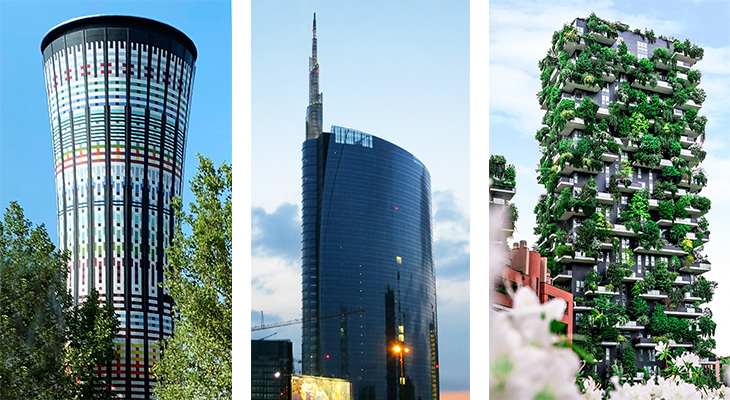 (Milan Towers Montage Photos: Anita Hamilton/ 50+ World)
(Milan Towers Montage Photos: Anita Hamilton/ 50+ World)
The 115 ft Rainbow Tower (Torre Arcobaleno) is a circular, concave water tower that was built of plain grey concrete, before it was covered in 100,000+ colourful ceramic tiles in anticipation of the 1990 World Cup events held in Milan. (Photo: © 2019 Anita Hamilton)
A modern blue glass Unicredit Tower with an LED-covered spire holds the record for the tallest building in Italy (758 ft). (Unicredit Tower Photo: Demis Gallisto)
Near the Unicredit Tower are the unique Bosco Verticale towers, with mature trees and shrubs on the exterior at every level. (Bosco Verticale Photo: Zac Wolff via Unsplash)
Sforza Castle and the Kingdom of Italy
Our tour bus continued along down Milan’s broad residential and business avenues lined with Georgian-style architecture, many of which date back to the 1700s.
Historical Note #3: French Revolutionary War General Napoleon Bonaparte defeated Austrian, Papal, and other forces when he invaded northern Italy in the 1790s. He created the Kingdom of Italy in 1805 and was subsequently titled Emperor of the French and the King of Italy. Napoleon’s control of Italy encompassed the northerly Italian regions of Lombardy, Liguria, Marche, Tuscany, Piedmont, Umbria, Veneto, Lazio, Trentino, and Emilia-Romagna.
Bonaparte made Milan the capital of his kingdom, while other cities and major tourist centres of today under his power back then included Bologna, Venice and the islands of the Venetian Lagoon, Parma, Trieste, the Italian Riviera, Pisa, and Florence.
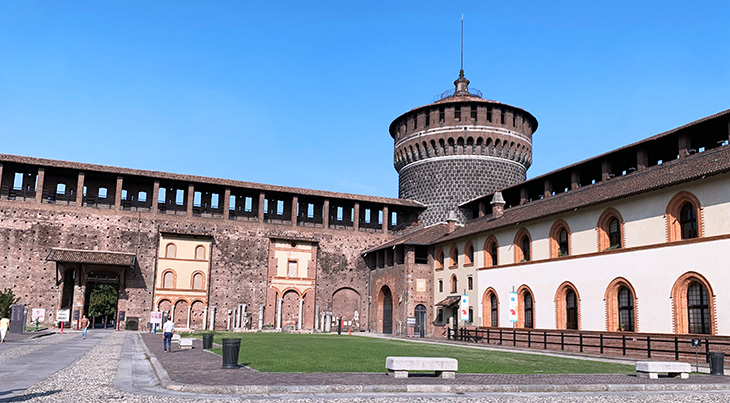 (Sforza Castle Interior Courtyard, Milan, Italy Photo: © 2019 Anita Hamilton/ 50+ World)
(Sforza Castle Interior Courtyard, Milan, Italy Photo: © 2019 Anita Hamilton/ 50+ World)
Francesco I Sforza, the fourth Duke of Milan (1450-1466), built Sforza Castle (Castello Sforzesco) on top of the existing 14th century Porta Zubia Castle (Castello di Porta Giova). Porta Zubia castle was destroyed in a 1447 battle, and Francesco Sforza began building his new castle in 1450.
The main entrance to the castle is through the 70 m. tall Torre del Filarete, facing into the heart of Milan.
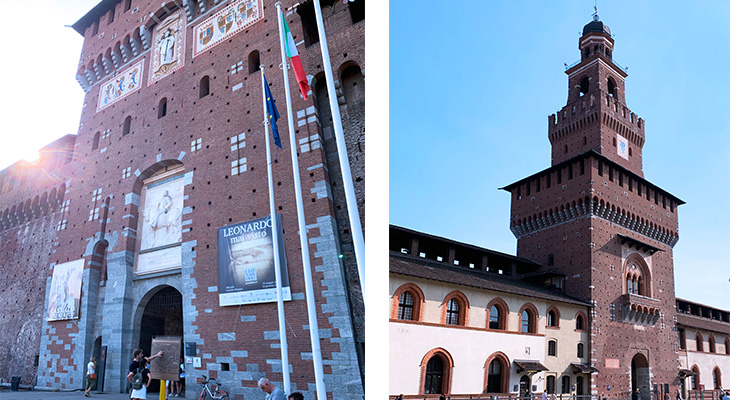 (Sforza Castle Torre del Filarete Exterior Entrance Closeup and Interior View Photo: © 2019 Anita Hamilton/ 50+ World)
(Sforza Castle Torre del Filarete Exterior Entrance Closeup and Interior View Photo: © 2019 Anita Hamilton/ 50+ World)
On either corner of this long southerly wall of Sforza Castle with the Torre del Filarete in the centre, are two round towers; while at either corner of the opposite northerly wall are two square towers.
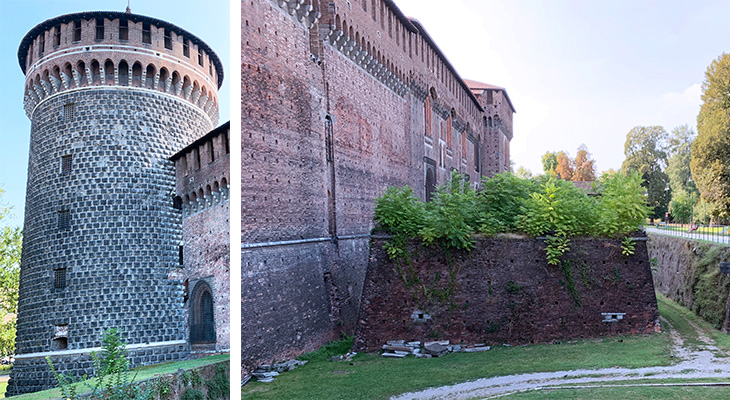 (Sforza Castle Round Tower, Exterior Wall and Moat Closeup Photo: © 2019 Anita Hamilton/ 50+ World)
(Sforza Castle Round Tower, Exterior Wall and Moat Closeup Photo: © 2019 Anita Hamilton/ 50+ World)
A deep, wide moat once surrounded the castle; imagine a modern city bus driving on the exposed tracks and you’ll get a sense of the true scale.
Subsequent Sforza family rulers continued construction on the castle after Francesco’s death. His fourth son Ludovico il Moro (The Moor) was Duke of Milan from 1494-1499, and invited artists such as Leonardo Da Vinci to decorate the castle with frescoes.
Historical Note #4: Our tour guide explained that Leonardo da Vinci was very important in the history of Milan, having lived in the city for 20 years. Da Vinci initially came to Milan as a musician, and invented an instrument to appeal to the king. Later his genius in art, architecture, science, and engineering came to be known across Italy.
Leonardo da Vinci’s painting of The Last Supper was completed in the late 1490s and was initially part of a commission by then Duke of Milan Ludovico Sforza. It is currently housed in the Convent of Santa Maria delle Grazie in Milan. Several members of our tour group made a point of seeing The Last Supper painting while in Milan, a once-in-a-lifetime opportunity.
Sforza Castle changed hands over the ensuring centuries as the Sforza family lost control of Milan, and different European invaders (Spain, France, Austria, and France again) came to power.
General Bonaparte had bricks taken from the castle to use for army barracks, housing for his generals, and other military purposes. Today several museums are housed within the castle walls and it’s towers.
Outside the castle walls, looking out from the Torre del Filarete side towards Milan, is the beautiful Piazza Castello fountain, and beyond that the curved Foro Bonaparte (Bonaparte Boulevard) with it’s wide streets and neo-classical buildings c. the early 1800s.
 (Piazza Castello Fountain and Bonaparte Boulevard Photo: © 2019 Anita Hamilton/ 50+ World)
(Piazza Castello Fountain and Bonaparte Boulevard Photo: © 2019 Anita Hamilton/ 50+ World)
Unfortunately, we didn’t get to the see triumphal Arco della Pace / Arch of Peace below in Piazza Sempione / Simplon Square, located outside the castle walls on the other side….something to add to our wish list / next visit to Milan.
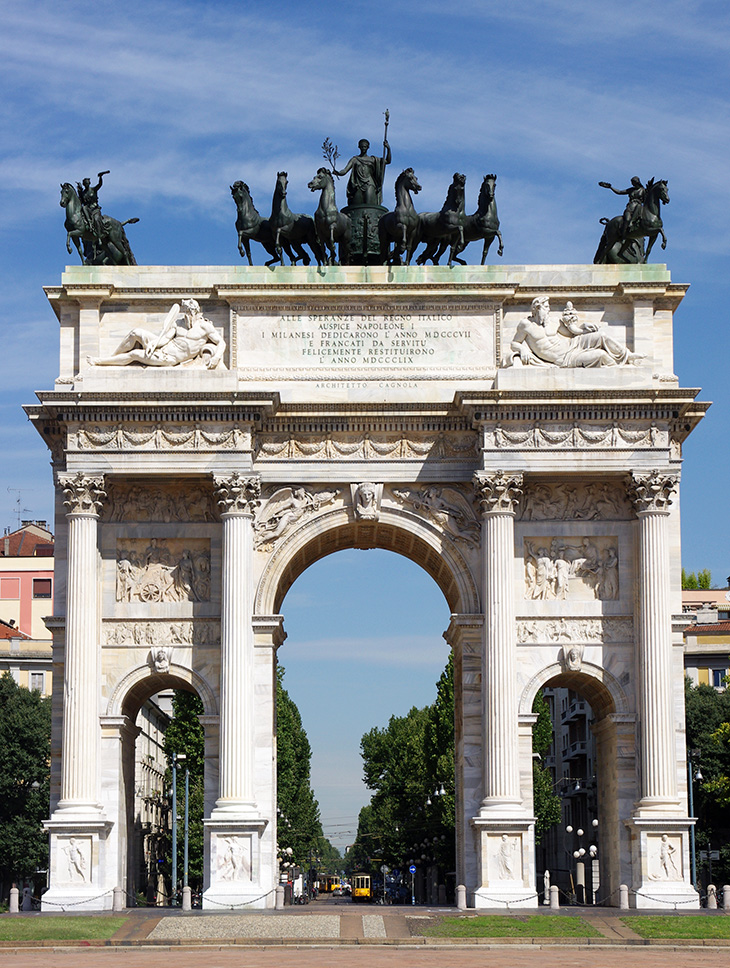 (Arco della Pace / Arch of Peace, Milan, Italy Photo: Jakub Halun)
(Arco della Pace / Arch of Peace, Milan, Italy Photo: Jakub Halun)
The Arch of Peace was designed by city architect Luigi Cagnola; construction began in 1807 and after numerous stops and starts due to wars etc., it was completed in 1838.
Duomo di Milano / Milan Cathedral
By the time our tour bus deposited us near the historic city centre of Milan, I was beginning to feel emotional about how beautiful the city was (I might have been overtired!). We’d driven down one street after another, seen private homes and commercial buildings – and I had an overwhelming impression of light, space, and grace. It wasn’t just the elegant design of the buildings, it was the attention to detail in the planning of the city that impressed me, with broad main boulevards that could accommodate vehicle traffic and pedestrians, ample trees, and parks.
We walked down a city street and as we turned the corner behind our tour guide, the Cathedral of Milan came into view. Tears came to my eyes as the sun shone on the front of the beautiful Duomo di Milano.
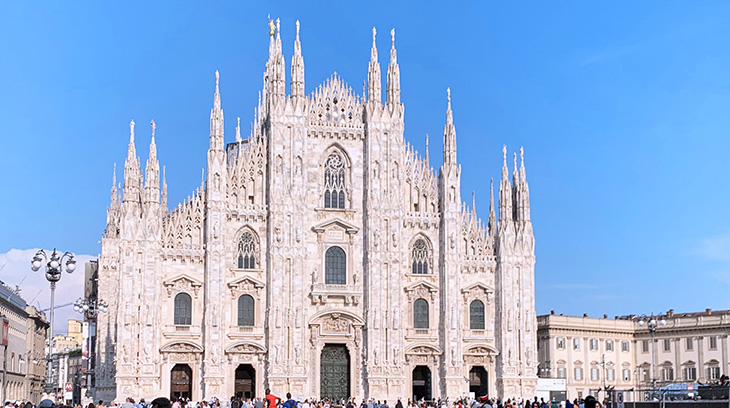 (Milan Cathedral / Duomo di Milano, Italy Photo: © 2019 Anita Hamilton/ 50+ World)
(Milan Cathedral / Duomo di Milano, Italy Photo: © 2019 Anita Hamilton/ 50+ World)
The Cathedral sits at one end of the wide, rectangular Piazza del Duomo. It looks like a delicate, sugar-spun fairy castle with the sunlight shining on it. The pinkish-white marble it’s built of makes it gleam brightly. It’s the largest church in Italy (after St. Peter’s Basilica in Vatican City). Later on our tour of Lake Como, I’d note some similarities between the Como Cathedral and Milan’s Duomo.
Historical Note #5: The Duomo di Milano is built on the foundations of what had been older buildings dating back to Roman times. Over the 600 years that it took to complete the Cathedral, several different archbishops, chief engineers, architects, and architectural styles came and went.
- Construction began in 1386 of what was intended to be a Lombard Gothic-style brick cathedral.
- Plans soon changed and by 1389, the then Duke of Milan – Gian Galeazzo Visconti – arranged for the church to be built of Candoglia marble (from the Lake Maggiore area) in the French Rayonnant Gothic style.
- By 1402 the church was half built, but construction then slowed. Different elements of this massive building were completed at different points over the next 170 years.
- In 1571 a new archbishop (Carlo Borromeo, of the wealthy Borromeo family that owns Isola Bella on Lake Maggiore) planned on a new architectural style for the exterior, appropriately called Renaissance. In the early 1600s, Federico Borromeo had the foundations for that new Renaissance facade laid, and work continued on it until 1638.
- In 1649 a new architect reverted to the original Gothic style. In 1762 the Madonna’s Spire / Statue was completed, designed by Carlo Pelllicani and Giuseppe Perego.
- When General Napoleon Bonaparte came to power in 1805 he pushed for the completion of the church facade by Pellicani, who followed the Gothic style already in progress, and added some neo-Gothic touches to the facade. Bonaparte was crowned King of Italy at the Duomo that same year.
- More Cathedral details (arches, spires, stained glass windows, gates, etc.) continued to be worked on throughout the 1800s and 1900s, with a delay for World War II when Allied bombing caused some damage. The Duomo di Milano was finally completed in 1965.
Galleria Vittorio Emanuele II and Statue
The Piazza del Duomo has also existed since the 1300s. It was expanded several times, with the surrounding buildings torn down and new ones erected over a period of approximately 600 years, to achieve it’s present appearance.
Architect Giuseppe Mengoni designed the current rectangular layout of the plaza in the mid-1800s, as well as the magnificent buildings along each side.
The Cathedral of Milan occupies one end of the Piazza del Duomo, while at the other end is the equestrian statue of Vittorio Emanuele II, erected in 1896. Enclosing the bottom of the statue on all sides is a cement barrier that doubles as seating for weary tourists and/or shoppers.
Historical Note #6: Victor Emanuele II became the first King of a newly united Italy in 1861. Only Rome and the regions of Trentino and Veneto held out; they were all joined by 1870. King Victor Emanuele II made Rome the new capital of a unified Italy in 1871.
On one side of the Piazza del Duomo is the resplendent Galleria Vittorio Emanuele II shopping arcade, with it’s magnificent arched entrance (reminiscent of the design of the Arco della Pace near Castle Sforza).
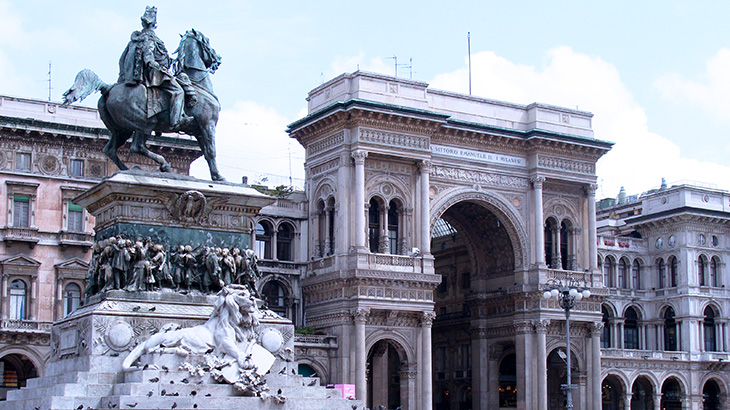 (Vittorio Emanuele II Statue, Galleria Vittorio Emanuele Entrance, Milan 2008 Photo: Marek Silarski)
(Vittorio Emanuele II Statue, Galleria Vittorio Emanuele Entrance, Milan 2008 Photo: Marek Silarski)
Inside, the Galleria is as impressive and ornate as the imposing exterior and entrance. Designed by architect Giuseppe Mengoni, it was built in completed in 1867 and stands four stories tall, with marble floors, two long intersecting iron and glass vaulted arcades and a central octagonal space with a glass dome ceiling.
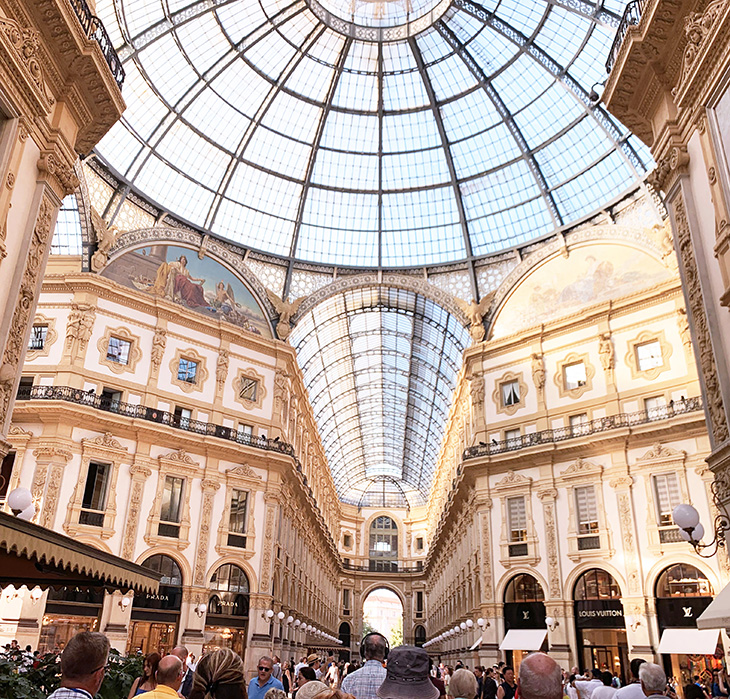 (Galleria Vittorio Emanuele Interior Central Dome, Milan, Italy Photo: © 2019 Anita Hamilton/ 50+ World)
(Galleria Vittorio Emanuele Interior Central Dome, Milan, Italy Photo: © 2019 Anita Hamilton/ 50+ World)
Along the other one side of the Piazza del Duomo is a museum, a smaller plaza leading to the Royal Palace of Milan, and various commercial and government buildings.
Piazza della La Scala
On the other side of the Galleria Vittorio Emanuele II is Piazza della Scala, and perhaps the most famous opera venue in the world, La Scala Opera House / Teatro alla Scala.
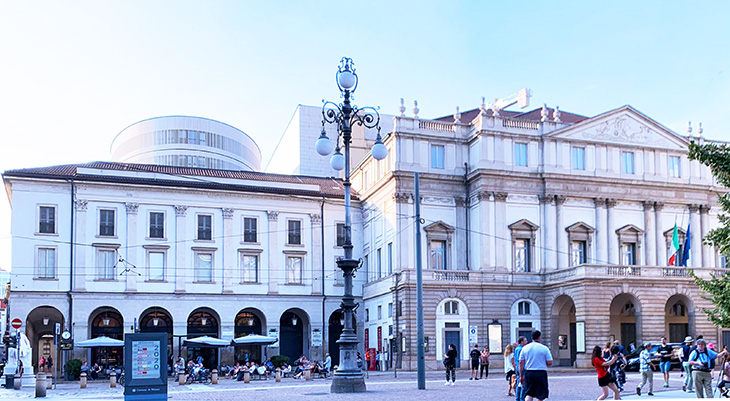 (La Scala Opera House on Piazza della Scala Photo: © 2019 Anita Hamilton/ 50+ World)
(La Scala Opera House on Piazza della Scala Photo: © 2019 Anita Hamilton/ 50+ World)
The gothic Santa Maria alla Scala church built in 1381 was torn down in 1776 to allow for construction of the new La Scala opera house, after a previous local theatre had burned down that year.
Restorations have been done on La Scala over the years, particularly after bomb damage during World War II, and another significant renovation in the early 2000s.
In the centuries since La Scala first opened in 1778, it has hosted legendary operas and singers from around the world. In addition to operas, ballets and orchestra concerts are performed at La Scala. A museum and several schools on the premises provide training in the performing arts and stage management.
The thriller Avalanche Express (1979), starring Lee Marvin, Robert Shaw, Linda Evans, Maximilian Schell, Joe Namath, Horst Buchholz, and Mike Connors, was filmed in part in Milan, and in the La Scala opera house specifically.
The Piazza della Scala was only created in the late 1800s, prior to that the famous opera house looked onto buildings on the other side of the street. In the centre of the plaza is a statue of Leonardo da Vinci. Small palaces and the Banca Commercial building – all dating to the late 1800s/early 1920s – sit along the perimeter of the plaza.
Church of Saint Joseph
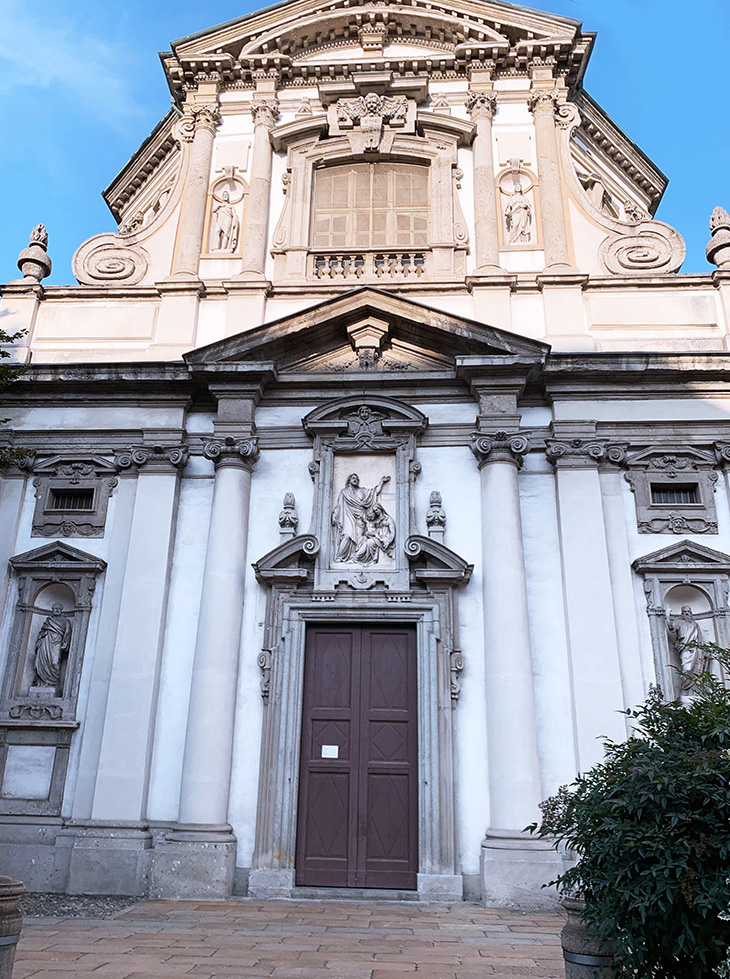 Chiesa di San Giuseppe Photo: © 2019 Anita Hamilton/ 50+ World)
Chiesa di San Giuseppe Photo: © 2019 Anita Hamilton/ 50+ World)
Tucked away on a street behind Piazza la Scala is one of the oldest original structures in Milan, the Church of San Giuseppe.
Designed by Italian Baroque architect Francesco Maria Richini, the church was completed in 1630.
It’s not a large building but it’s quite ornate and elegant, and very well preserved.
Our tour group ended the day at Il Kaimano, a lovely Italian restaurant serving traditional Milanese foods. Our antipasto starter of cherry tomatoes, boconnoni cheese, arugula salad, and prosciutto was light and tasty. Saffron risotto with fried breaded veal was equally delicious, and the fruit salad that ended our meal was good.
We spent a total of 1 days in a Milan (really only 3/4 of a day as we arrived late in the morning), but managed to pack in quite a few sights. This is definitely a city that you could easily spend much more time in.
Although I was looking forward to the next stops on our tour (the ancient city of Verona; Cortina d’Ampezzo and the Dolomites; a prosecco wine-tasting, Trento, etc.), it was hard to say goodbye to Milan after such a short but wonderful visit.
Molto grazie, Milan. Many thanks for your friendly hospitality and making it easy for travelers and tourists to enjoy seeing your magnificent architecture – making part of my dream vacation to Italy come true.
On our way back to Milan we detoured north of the city to spend time in the Italian Lakes District and visit Lake Garda.
If you enjoyed this article, you may also like:
Venetian Palazzos in Movies and Plays
The Heart of Venice: St. Mark’s Square
*This article is for general informational purposes only. 50+ World does endorse these providers, nor does it receive remuneration from them.*
**Unless indicated otherwise, all photographs & text in this article are © 2019 Anita Hamilton. All rights reserved. Do not download or reproduce without written permission. Other images are either public domain and/or creative commons licensed and sourced via Wikimedia Commons or Flickr**
